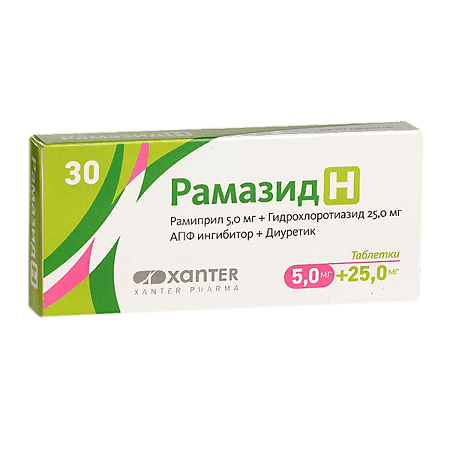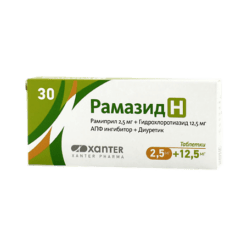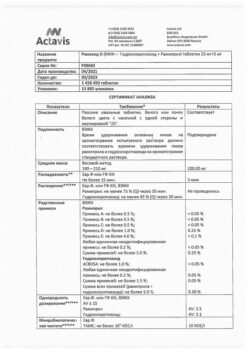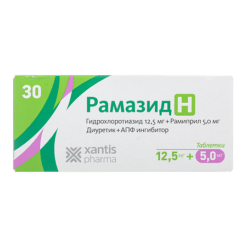No products in the cart.
Ramazid N, tablets 5 mg+25 mg 30 pcs
€15.17 €12.65
Description
Arterial hypertension (patients who are indicated for combination therapy).
Indications
Indications
Arterial hypertension (patients for whom combination therapy is indicated).
Pharmacological effect
Pharmacological effect
Ramipril
Special instructions
Special instructions
Ramipril
At the beginning of treatment, renal function should be assessed. It is necessary to carefully monitor renal function during treatment with ramipril, especially in patients with weakened renal function, with damage to the renal vessels (for example, clinically insignificant renal artery stenosis or hemodynamically significant stenosis of the artery of a solitary kidney); heart failure.
The risk of hypersensitivity and allergy-like (anaphylactoid) reactions is increased in patients concomitantly taking ACE inhibitors and undergoing hemodialysis using AN69 dialysis membranes. Similar reactions have been observed with low-density lipoprotein apheresis using dextran sulfate, so this method should be avoided during treatment with ACE inhibitors.
During treatment with ramipril in patients with impaired renal function, especially with simultaneous treatment with diuretics, serum urea and creatinine levels may increase. In this case, treatment should be continued with lower doses of ramipril or the drug should be discontinued. In patients with impaired renal function, the risk of hyperkalemia increases.
In patients with impaired liver function, due to a decrease in the activity of liver enzymes, the metabolism of ramipril and the formation of an active metabolite may be slowed down. In this regard, treatment of such patients should only be started under strict medical supervision.
Caution must be exercised when prescribing ramipril to patients on a low-salt or salt-free diet (increased risk of arterial hypotension). In patients with a reduced circulating blood volume (as a result of diuretic therapy), during dialysis, with diarrhea and vomiting, symptomatic hypotension may develop.
Transient arterial hypotension is not a contraindication for continuing treatment after stabilization of blood pressure. If severe arterial hypotension reoccurs, the dose should be reduced or the drug discontinued.
In patients undergoing major surgery or receiving other agents that cause hypotension during general anesthesia, ramipril may cause blockade of angiotensin II formation due to compensatory release of renin. If the physician associates the development of arterial hypotension with the mechanism mentioned above, arterial hypotension can be corrected by increasing blood plasma volume.
In rare cases, agranulocytosis, erythrocytopenia, thrombocytopenia, hemoglobinemia or bone marrow suppression have been observed during treatment with ACE inhibitors. At the beginning and during treatment, it is necessary to monitor the number of white blood cells to detect possible neutropenia/agranulocytosis. More frequent monitoring is recommended in patients with renal failure, with connective tissue diseases (eg, systemic lupus erythematosus or scleroderma) and in patients concomitantly taking medications that affect hematopoiesis. Counting blood cells should also be carried out if clinical signs of neutropenia/agranulocytosis and increased bleeding occur.
In patients with arterial hypertension, when treated with ramipril, an increase in serum potassium levels is rarely observed. The risk of hyperkalemia increases with chronic heart failure, simultaneous treatment with potassium-sparing diuretics (spironolactone, amiloride, triamterene) and the prescription of potassium supplements.
When using ACE inhibitors during desensitization therapy to wasp or bee venom, anaphylactoid reactions (eg, hypotension, shortness of breath, vomiting, skin rash) may occur, which can be life-threatening. Hypersensitivity reactions may occur from insect bites (eg bees or wasps). If it is necessary to carry out desensitizing treatment with bee or wasp venom, it is necessary to discontinue ACE inhibitors and continue treatment with suitable drugs from other groups.
During treatment with Ramazid N, care must be taken when driving vehicles and engaging in other potentially hazardous activities that require increased concentration and speed of psychomotor reactions (dizziness is possible, especially after the initial dose of an ACE inhibitor in patients taking diuretic drugs). Patients are advised to refrain from driving or operating machinery until the response to treatment is clear.
Hydrochlorothiazide
To prevent K+ and Mg2+ deficiency, potassium-sparing diuretics, K+ and Mg2+ salts are prescribed. Regular monitoring of plasma levels of potassium, glucose, uric acid, lipids and creatinine is necessary.
Active ingredient
Active ingredient
Hydrochlorothiazide, Ramipril
Composition
Composition
1 tab. – ramipril 5 mg,
Pregnancy
Pregnancy
The drug is contraindicated during pregnancy and lactation.
Contraindications
Contraindications
Ramipril
– hypersensitivity to ramipril and any other ingredient of the drug or other ACE inhibitors;
– history of angioedema, including that associated with previous therapy with ACE inhibitors;
– hemodynamically significant bilateral renal artery stenosis;
– stenosis of the artery of the only kidney;
— condition after kidney transplantation;
– hemodialysis;
— renal failure (creatinine clearance less than 20 ml/min.);
– hemodynamically significant aortic or mitral stenosis (risk of excessive reduction in blood pressure with subsequent impaired renal function);
— hypertrophic obstructive cardiomyopathy;
– primary hyperaldosteronism;
— pregnancy and lactation;
– age under 18 years (efficacy and safety have not been established).
With caution: severe damage to the coronary and cerebral arteries (danger of decreased blood flow with an excessive decrease in blood pressure), unstable angina, severe ventricular arrhythmias, chronic heart failure stage IV, decompensated “pulmonary heart”, renal and/or liver failure, hyperkalemia, hyponatremia (including against the background of diuretics and a diet with limited salt intake), conditions accompanied by a decrease in circulating volume blood (including diarrhea, vomiting), systemic connective tissue diseases, diabetes mellitus, suppression of bone marrow circulation, old age.
Hydrochlorothiazide
– hypersensitivity to the drug;
– gout;
— diabetes mellitus (severe forms);
– chronic renal failure (creatinine clearance less than 20-30 ml/min, anuria);
– refractory hypokalemia;
– hypercalcemia;
– hyponatremia;
— pregnancy (1st trimester);
– lactation period.
With caution: hypokalemia, hyponatremia, hypercalcemia, coronary heart disease, liver cirrhosis, old age.
Side Effects
Side Effects
Ramipril
From the cardiovascular system: decreased blood pressure, orthostatic hypotension, orthostatic collapse, tachycardia, rarely – arrhythmia, angina pectoris, myocardial infarction. From the genitourinary system: development or intensification of symptoms of renal failure, proteinuria, decreased urine volume, decreased libido.
From the side of the central nervous system: cerebral ischemia, stroke, dizziness, headache, weakness, drowsiness, paresthesia, nervous excitability, anxiety, tremor, muscle spasm, mood disorders, when used in high doses – insomnia, anxiety, depression, confusion, fainting.
From the senses: vestibular disorders, disturbances of taste (for example, metallic taste), smell, hearing and vision, tinnitus.
From the digestive system: nausea, vomiting, diarrhea or constipation, pain in the epigastric region, intestinal obstruction, pancreatitis, hepatitis, cholestatic jaundice, impaired liver function with the development of liver failure, dry mouth, thirst, decreased appetite, stomatitis, glossitis.
From the respiratory system: “dry” cough, bronchospasm, shortness of breath, rhinorrhea, rhinitis, sinusitis, bronchitis.
Allergic reactions: skin rash, itching, urticaria, conjunctivitis, photosensitivity; angioedema of the face, extremities, lips, tongue, pharynx and/or larynx, exfoliative dermatitis, exudative erythema multiforme (including Stevens-Johnson syndrome), toxic epidermal necrolysis (Lyell’s syndrome), pemphigus, serositis, onycholysis, vasculitis, myositis, myalgia, arthralgia, arthritis, eosinophilia.
Other: convulsions, alopecia, hyperthermia, increased sweating.
Laboratory indicators: hypercreatininemia, increased levels of urea nitrogen, increased activity of “liver” transaminases, hyperbilirubinemia, hyperkalemia, hyponatremia, the appearance of antinuclear antibodies.
Effect on the fetus: impaired fetal function, decreased blood pressure in the fetus and newborns, impaired renal function, hyperkalemia, hypoplasia of the skull bones, oligohydramnios, contracture of the limbs, deformation of the skull bones, pulmonary hypoplasia.
Hydrochlorothiazide
From the side of the water-electrolyte and acid-base balance: the development of hypokalemia and hypochloremic alkalosis is possible (dry mouth, increased thirst, heart rhythm disturbances, changes in mood and psyche, cramps or muscle pain, nausea, vomiting, weakness; with hypochloremic alkalosis, the development of hepatic encephalopathy or hepatic coma is possible), hyponatremia (confusion, convulsions, apathy, slow thinking, fatigue, irritability), hypomagnesemia (arrhythmias).
From the hematopoietic system: agranulocytosis, thrombocytopenia, hemolytic and aplastic anemia, leukocytopenia.
From the cardiovascular system: arrhythmia, orthostatic hypotension, tachycardia.
From the digestive system: cholecystitis, pancreatitis, jaundice, diarrhea, sialadenitis, constipation, anorexia, epigastric pain.
Metabolism: hyperglycemia, glycosuria, hyperuricemia, exacerbation of gout.
Allergic reactions: skin rash, purpura, necrotizing vasculitis, Stevens-Johnson syndrome, respiratory distress (pneumonitis, non-cardiogenic pulmonary edema), photosensitivity; anaphylactic reactions (up to life-threatening anaphylactic shock).
Interaction
Interaction
Ramipril
Strengthens the inhibitory effect of ethanol on the central nervous system. Taking salt with food may reduce the hypotensive effect of ramipril.
With the simultaneous use of ramipril and other drugs that lower blood pressure (eg, diuretics, nitrates, tricyclic antidepressants, anesthetics) leads to an increase in the hypotensive effect of ramipril.
The simultaneous administration of ramipril and potassium preparations or potassium-sparing diuretics, it is necessary to control the concentration of lithium in the blood serum – the risk of toxic effects. icov can cause hyperkalemia.
Vasopressor sympathomimetics (adrenaline, norepinephrine) can reduce the hypotensive effect of ramipril. In this regard, during simultaneous treatment, blood pressure levels should be carefully monitored.
The simultaneous administration of ramipril and allopurinol, immunosuppressants, corticosteroids, procainamide, and cytostatics increases the likelihood of changes in the peripheral blood picture.
The simultaneous administration of ramipril and lithium preparations leads to a decrease in l
excretion
ACE inhibitors may enhance the effect of hypoglycemic agents (for example, insulin or sulfonylureas), which in some cases may cause hypoglycemia. Therefore, blood sugar levels should be carefully monitored, especially when coadministration is initiated.
The simultaneous use of ramipril and non-steroidal anti-inflammatory drugs (for example, acetylsalicylic acid and indomethacin) may weaken the hypotensive effect of ramipril. Additionally, concurrent use may cause hyperkalemia and increase the risk of renal impairment.
Concomitant use of heparin and ramipril may cause hyperkalemia.
Anaphylactic and anaphylactoid reactions to stinging insect venom (possibly to other allergens) are more pronounced during treatment with ACE inhibitors.
Hydrochlorothiazide
With the simultaneous use of digitalis glycosides with thiazide diuretics, the likelihood of toxic effects of glycosides (including increased ventricular excitability) increases due to the likely development of hypokalemia and hypomagnesemia.
Medicines that intensively bind to proteins (indirect anticoagulants, clofibrate, NSAIDs) enhance the diuretic effect of hydrochlorothiazide.
The hypotensive effect of hydrochlorothiazide is enhanced by vasodilators, beta-blockers, barbiturates, phenothiazines, tricyclic antidepressants, ethanol. Hydrochlorothiazide enhances the neurotoxicity of salicylates, weakens the effect of oral hypoglycemic drugs, norepinephrine, epinephrine and anti-gout drugs, enhances the cardiotoxic and neurotoxic effect of lithium preparations, the effect of peripheral muscle relaxants, and reduces the excretion of quinidine. When taking methyldopa simultaneously, hemolysis may develop. Cholestyramine reduces the absorption of hydrochlorothiazide.
Hydrochlorothiazide reduces the effect of oral contraceptives.
Overdose
Overdose
Symptoms: marked decrease in blood pressure, bradycardia, shock, water-electrolyte imbalance, acute renal failure, stupor, dry mouth, weakness, drowsiness.
Treatment: place the patient in a horizontal position with raised legs, in mild cases of overdose – gastric lavage, administration of adsorbents and sodium sulfate (it is advisable to carry out measures within the first 30 minutes after taking the drug). When blood pressure decreases – intravenous administration of catecholamines, angiotensin II; for bradycardia – use of a pacemaker. The drug is not excreted during hemodialysis.
Recommendations for use
Recommendations for use
Inside. the dose is selected individually. The usual dose for adults is 1 tablet. Ramazid H2.5 mg/12.5 mg per day. If necessary, can be increased to 1 tablet. Ramazid N 5 mg/25 mg.
In case of mild or moderate renal dysfunction (creatinine clearance more than 30 ml/min, serum creatinine approximately 3 mg/dl or 265 µmol/l), the usual dose of the drug is recommended. When creatinine clearance is less than 30 ml/min, the drug is not recommended.
Storage conditions
Storage conditions
At a temperature not higher than 25°C. Keep out of the reach of children!
Shelf life
Shelf life
At a temperature not higher than 25°C. Keep out of the reach of children!
Manufacturer
Manufacturer
Actavis Ltd, Malta
Additional information
| Shelf life | At a temperature not exceeding 25°C. Keep out of reach of children! |
|---|---|
| Conditions of storage | At a temperature not exceeding 25°C. Keep out of reach of children! |
| Manufacturer | Actavis Ltd, Malta |
| Medication form | pills |
| Brand | Actavis Ltd |
Other forms…
Related products
Buy Ramazid N, tablets 5 mg+25 mg 30 pcs with delivery to USA, UK, Europe and over 120 other countries.


















